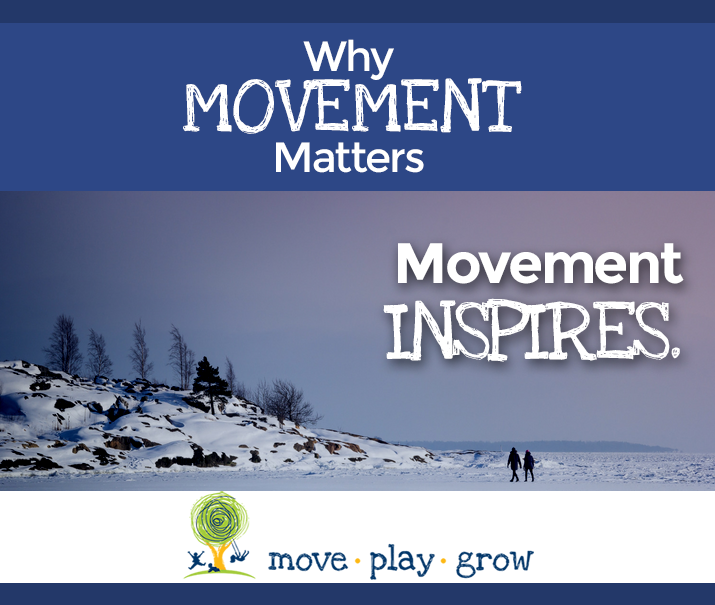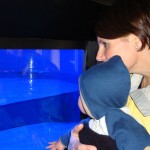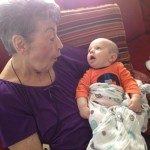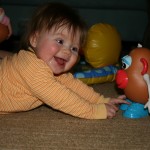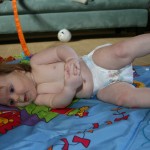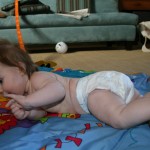Sitting is the new smoking. And, yet, “sitting still” is the gold standard for good behavior in preschoolers? We continually design technologies to position and do and move for us. And, yet, we expect our littles to be more independent?
Everything we do, all that we be requires movement. Yet in our culture, starting as babies and lasting through the golden years, we don’t move the way we were designed. Nor do we nourish our body and brain with the movement required for optimal health and well being. The consequences are big:
- Flat-head syndrome and asymmetry in babies (1 in 5!).
- Higher-level motor skills not reached in 5-year-olds, a sign they won’t be accomplished at all.
- Back pain in elementary students.
- High and rising rates of depression, anxiety with all the secondary consequences in adolescents.
- The skyrocketing incidence of metabolic disease, obesity, emotional health breakdown.
The list goes on.
We are failing at nourishing our bodies and brains with the movement required for optimal health.
Only 22% of children get the required amount of exercise per day. And, it’s worse with adults…18%. But, when we design public places with escalators next to stairs (or worse, hide the stairs), is it any wonder? I frequently see people line up to get on the escalator when the stairs are EMPTY! We are waiting in line to not move even more! Doesn’t that seem CRAZY?!?
But there are solutions. Many. And everyone can find one that works for them.
You do not need to be an Olympian triathlete to reap the benefits of exercise. You just need to be aware and to choose to move.
The brain and body work together
Behavior becomes biology. Form follows function. Our skeletons were designed to walk and run. Our brains were designed to feel, to process, to plan and execute, to problem solve, to create. The “soft-wired” integration of brain and body connections is plastic, malleable, adaptable, flexible. And we change the structure and chemistry of our brain DAILY!
If we neglect one part, the other will “feel the pain.” If we feed both body and brain what each need, we don’t just survive, we THRIVE! And, the change happens as soon as you DECIDE and ACT.
So, what happens when we DO move our bodies? When we do get outside? Just stepping outside and moving your body decreases your worry and anxiety. Even if you can’t directly control the circumstances around you, you can change the way you respond. Being outside helps you to get present in the NOW. You relax, you feel connected and nourished, integrated and whole. You feel FREE and, therefore, better equipped to respond.
What else happens when you move? Here’s what the research says:
EXERCISE…
- Enhances learning capacity. 20 minutes of exercise where your heart rate is at 70-90% of its maximum increases your focus and learning capacity for up to four HOURS afterward. Just think what our kids could learn if PE were FIRST in the day. Before-school running/ninja warrior clubs come to mind. It’s NOT just about more hours in the classroom. Let’s be strategic, effective and efficient. >>> Get your FREE JUMPSTART PE classes HERE
- Boosts brain drivers! Exercise modulates and enhances the activity of dopamine, norepinephrine, serotonin in the brain, responsible for how we feel, think, adapt, problem solve, remember, move, and keep our brain structure HEALTHY AND GROWING. The benefits are dosage-dependent, but it ALWAYS begins with ONE STEP.
- Improves your mood. This is a BIG one and I see it with myself, my husband and my children on a daily basis. My kids know to send me outside or to the gym when I start to “lose it.” And I know that when kid behavior gets “crazy,” outside time with them (combining movement, outdoors and quality time) is GOLDEN!
- Increases your focus. Moms, multi-tasking is NOT something to aspire to. Sometimes it’s necessary, but it is not efficient and effective. Distractability isn’t just a “thing” for kids. Get some movement (dance, jumping jacks, high knees, mountain climbers, jumpies, you name it) and then define a “Power 20!” Give yourself ONE task and do it for 20 minutes. Be amazed at all that can be accomplished in a short time.
- Protects your brain. Just as pumping iron increases your muscle mass, exercise in the long-run increases brain growth, especially in the prefrontal cortex and hippocampus. These areas are essential for executive functioning and laying down memories. The more robust they are, the stronger foundation there is for any neuro-degeneration in the future. Do the work NOW and CONSISTENTLY. I know we all say it, but you really have nothing if you don’t have your health. Take care of you, because YOU is all you have. Get moving!
- Launches you into high performance. You need (at minimum) 3-4 times per week of vigorous exercise, 30 minutes per session. BUT, even 5 minutes is better than NONE so as Nike says, “Just Do It!” Also, if you want to be a “high performer” in your life, increase that to 5x/week!
Exercise is the MOST TRANSFORMATIVE thing you can do for yourself TODAY. Of course there are other physical, emotional, and psychological pillars of health required for maximum performance, but NONE of them have such a PROFOUND, IMMEDIATE effect as exercise. Take it to heart, practice it over and over, and inspire your kids to do the same.
What about the flip side?
When you don’t move, you limit your ability to participate (now and in the future); your heart strains to keep the blood moving; your muscles atrophy; you experience pain; your endurance plummets; your brain deteriorates; you are weak; you have trouble playing on the floor with your babies and grandbabies; you are frail and fragile, ready to break.
Of course that’s not YOU, though…Right? The problem is, you won’t recognize any of the above until it’s reached a critical point. And you certainly won’t see the difference between where you are today and where you could be unless you commit to moving vigorously and often.
A sedentary life is unhealthy. There is no way around it. And it’s certainly the outcome your children will face if the love of moving and participating and pushing their body to the limits isn’t ingrained from an early age. It’s never too late to start, AND it’s always easier the earlier it becomes a habit.
Get out and move!
You don’t need to be a fine-tuned athlete or rugged outdoors person. If it’s like pulling teeth to get you out the door, it’s ok. Any type of movement can inspire and make a difference. You may need to dig a little deeper to find what lights you up, but I promise, it’s there. You have a body; it was designed to move, it wants to move, you just need to find what inspires.
And, sometimes you have to climb Mt. Everest of resistance just to reach the start. If getting going is your pain point, recognize that and create a no-back-door situation so you stop fighting an unnecessary battle. Save the battle for when your body wants to quit! And, know that will power is not enough. A plan with best intentions is not enough. You need accountability.
Find a partner who won’t let you back out. A class that will charge you if you don’t show up. Add your movement time in your calendar and star it as the MOST IMPORTANT meeting of your day. Do NOT cancel on yourself. (Side note: The way you do one thing is the way you do everything. If you cancel on yourself, you cancel on others, too.)
Make it fun and inspiring, think outside the box. Parkour, pole dancing, belly dancing, surfing, plyometric routine up and down your street (that was one of my favorite workouts in college). Meet a friend. Do it with your children and make it a game.
I was trying to inspire my 8-year-old son to do pushups. He didn’t want to. I told him I’d hold a plank until he finished them. I almost died holding that plank, and eventually, he pushed up 5 times and LOVED that he “saved” me! Laughter all over.
Oh, and if you laugh during your workout routine, you engage your core up to 40% more than doing core work alone! LAUGH A LOT!
Bottom line, don’t overanalyze your resistance. Just take your first step and GO! Every time you conquer that resistance, you create a win. Every win builds confidence. Every repetition builds resilience and grit. Every time you move, your body comes alive, and isn’t that what it’s all about?
Create environments where movement is inspired. The more you and your children move, the more you receive the benefits of that movement. And, the more you move, the more you want to move. Let’s all get on the spiral upward.
And, here’s the thing. It’s not just about your kids moving. It’s YOU moving WITH your kids. You don’t need to be there 100% of the time, but what they want is connection with you. Love them by moving with them, participating with them.
If you happen to coach sports, create opportunities for parents to come out and play the last 5 minutes of practice. I’ve done this for a few years now and it is SOOOOO fun. The only rule is that parents CANNOT talk. Their children get to lead and instruct and inspire and initiate the connection with YOU!
What if my child doesn’t want to move?
Sometimes I meet a family who talks about their easy baby (sometimes labeling “lazy baby”) being content sitting still and watching. Usually, mom and dad aren’t worried. They are grateful for the break. However, in the back of my mind, I wonder, what could be possibly going on with this baby that they don’t feel comfortable moving? Often, these are the kiddos who end up having some more overt challenges later on.
What to do? Don’t accept “Wait and See” as an answer. Don’t try to answer what’s going on with YOUR child by reading about other people’s children. Google casts a wide net, but it can’t go deep with you and your child. Everyone is unique and deserves to be seen as such. Schedule a screening or evaluation with a local pediatric physical therapist or occupational therapist. Get answers from the people who know infant and child development best.
Get Moving!
We are blessed to have bodies that feel, move, and connect. When we don’t move, we clog up our brain, our thoughts, and our emotions. Movement is essential to keep things free flowing. From day one until the day we say goodbye to this life, our body is our home. Honor it and give it what it needs. And then teach, show, and inspire your children the same.
Final Thoughts
If you want fun new ways to MOVE, I’m gifting you my JUMPSTART PE, Check it out HERE



